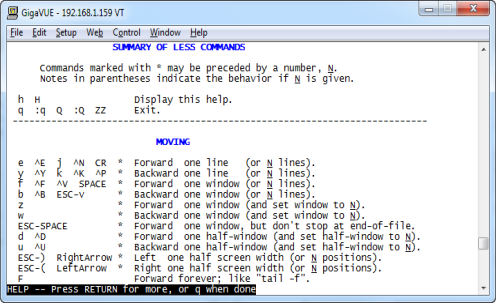Entering Commands in the CLI
The GigaVUE CLI provides several conventions that make it easy to identify available commands and enter them quickly:
|
Technique |
Description |
|||||||||
|
Context-Sensitive Help |
The ? symbol is the key to receiving help wherever you are in the CLI:
For example, if you typed i? in Configure mode, the CLI would return the following possible commands based on what you’ve entered so far: image interface ip
For example, if you entered gigastream ?, you would see alias. You can build your way through the entire command tree by entering ? after each new argument. For example, after entering gigastream alias myalias ?, you would see the next valid argument – port-list. Note: Typing ? accesses the help system immediately – you do not need to press <Enter>. |
|||||||||
|
Partial Command Entry |
For all GigaVUE commands and arguments, you only need to enter enough characters to distinguish the command from all other available commands. So, for example, you do not have to enter the full command username – there is only one command starting with the letter u, so you only have to enter u. |
|||||||||
|
Command Completion |
If you have partially typed a command, you can press Tab and the CLI will attempt to complete the command for you based on what’s been entered so far. It is helpful to use the Command Completion feature together with partial command entry – you can press Tab while entering a command to see a list of all available commands matching what you’ve entered so far. For example, you can press p<Tab> and the system will return: pass-all ping port port-pair Based on this information, you know that you only need to enter the letter pa to uniquely identify what you’ve entered as pass-all. |
Command-Line Syntax – Entering Commands
You enter configuration commands for the GigaVUE node in the command-line interface by typing enough characters to uniquely identify the command and pressing <Enter>.
When entering commands, keep in mind the following rules:
| Successful commands return no response in the CLI; commands with errors return an error response beginning with %, followed by a short error description. |
| All commands are case-sensitive and entered in lower case. |
| Port numbers are entered in <box ID>/<slot ID>/<port ID> format. For the GigaVUE TA Series nodes, the chassis ID and slot number are always 1. |
| Strings must consist entirely of alphanumeric characters with no spaces. The only exceptions are the underscore (_), hyphen (-), exclamation point (!), “at” symbol (@), and period (.) characters. Those are allowed. |
For example, in Config mode, port 1/1/q12 alias My_Alias is legal, but port 1/1/q12 alias My Alias is not.
Note: Some string fields do accept spaces provided the input is made inside quotation marks
Config Mode Syntax
When using the GigaVUE CLI, the “config” part of the command is implied whenever you are working in Configure mode. The system prompt helps you remember this by including the word (config) in parentheses. For example:
(config) #
So, instead of entering config map to connect a network port to a tool port, you just enter map followed by the necessary arguments. The config part is implied because you are already working in the Configure command mode. For example:
(config) # map alias myTA40map from 1/1/q1 to 1/1/q5
Paging through CLI Output
By default, the GigaVUE CLI returns output exceeding the configured terminal length in pages. The CLI provides the same features for working through the paged output as the Linux programs less and more. Press the h key to see paging options – Figure 1 provides an example.
If you prefer, you can disable paging either for the current session or by default:
| Disable for Current Session |
(config) # no cli session paging enable
| Disable for All Sessions (Default) |
(config) # no cli default paging enable

| Figure 24 | Viewing Paging Options |



